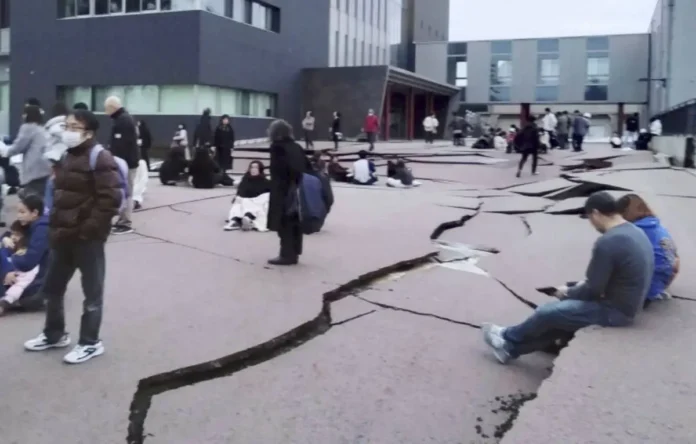TOKYO – A series of powerful earthquakes struck off the western coast of Japan’s main Honshu island on Monday afternoon, triggering tsunami warnings and evacuation orders for coastal regions.
The Japan Meteorological Agency reported more than a dozen tremors off the shores of Ishikawa and nearby prefectures shortly after 4 p.m. local time. The strongest measured a preliminary magnitude of 7.6, causing substantial shaking felt across a wide area.
Within minutes, the agency issued major tsunami warnings for the coasts of Ishikawa and Niigata prefectures, with alerts and advisories extending down the Sea of Japan coast from Hokkaido in the north to Kyoto in the southwest.
Residents were urged to evacuate immediately to high ground or tall buildings as forecasts predicted tsunami waves up to 5 meters (16 feet) high could crash ashore. Officials warned the tsunami waves could continue intermittently for several hours.
“Every minute counts. Please evacuate to safe areas immediately,” Chief Cabinet Secretary Yoshimasa Hayashi said in a nationally televised statement. He added it was critical for people near oceanfront areas to move to higher ground right away.
At least half a dozen homes collapsed in Ishikawa Prefecture, likely trapping occupants under rubble, according to local police and fire departments. A blaze also broke out in the coastal city of Wajima, where more than 30,000 households lost electricity.
While no casualties have been confirmed so far, Hayashi said the situation remains unclear amid continuing aftershocks. Japan’s military has joined local first responders in rescue and recovery efforts.
Harrowing footage from the region showed people fleeing on foot through buckled streets as tsunami sirens wailed in the background. Plumes of smoke billowed from neighborhood fires sparked by the tremors.
Massive fissures tore through roads and parking lots in some areas. In Kanazawa, the cultural capital of Ishikawa, centuries-old temple gates were damaged by the intense shaking.
Bullet train service in most of western Japan was suspended. Parts of several major highways also shut down, along with cell phone service outages in areas closest to the epicenter.
The Meteorological Agency warned at an emergency news conference Monday evening that the risk of major aftershocks remains substantially elevated over the next several days, especially in the next 48 hours.
Officials urged continued vigilance and caution in affected coastal regions where subsequent quake activity could trigger landslides or building collapses.
Japan is one of the most earthquake-prone countries in the world, situated along the volatile “Ring of Fire” arc of seismic activity in the Pacific Basin.
In March 2011, a magnitude 9.0 megathrust earthquake struck off the northeast coast, triggering a devastating tsunami that killed over 15,000 people and caused meltdowns at the Fukushima Daiichi nuclear plant – the worst nuclear disaster since Chernobyl.
Monday’s temblors occurred along a different fault, according to seismologists. Still, officials said nuclear plants in the region reported no abnormalities thus far.
The United States Geological Survey measured Monday’s largest quake at a magnitude of 7.4, with several above magnitude 6. Aftershocks are expected to continue, seismologists say.
Experts credit strict building codes with minimizing damage and casualties from major quakes in recent decades. But coastal communities remain vulnerable to tsunamis, highlighting the importance of early warning systems and public awareness.
Tsunami waves from subsequent aftershocks can often be larger than the initial wave,” said Lee Jae-yeong, an official at South Korea’s Meteorological Administration, which also issued alerts on the peninsula’s eastern coast.
In Russia, officials issued tsunami warnings for the southern Kuril Islands and coastal areas of the Kamchatka Peninsula.
Meanwhile, residents farther from the Japanese coastline described feeling long shakes and rumblings. Store shelves toppled in some places as the ground rolled.
“It just kept going and going,” said Hokuto Abe, who was at work in Tokyo when the quakes hit. “It was the longest I’ve ever felt. At first it was mild, but then it really started to rock.”
Despite the extent of Monday’s seismic activity, officials say Japan‘s stringent building codes prevented more catastrophic damage. The difficult part comes next, as the country once again picks up the pieces from Mother Nature’s volatile whims.





















